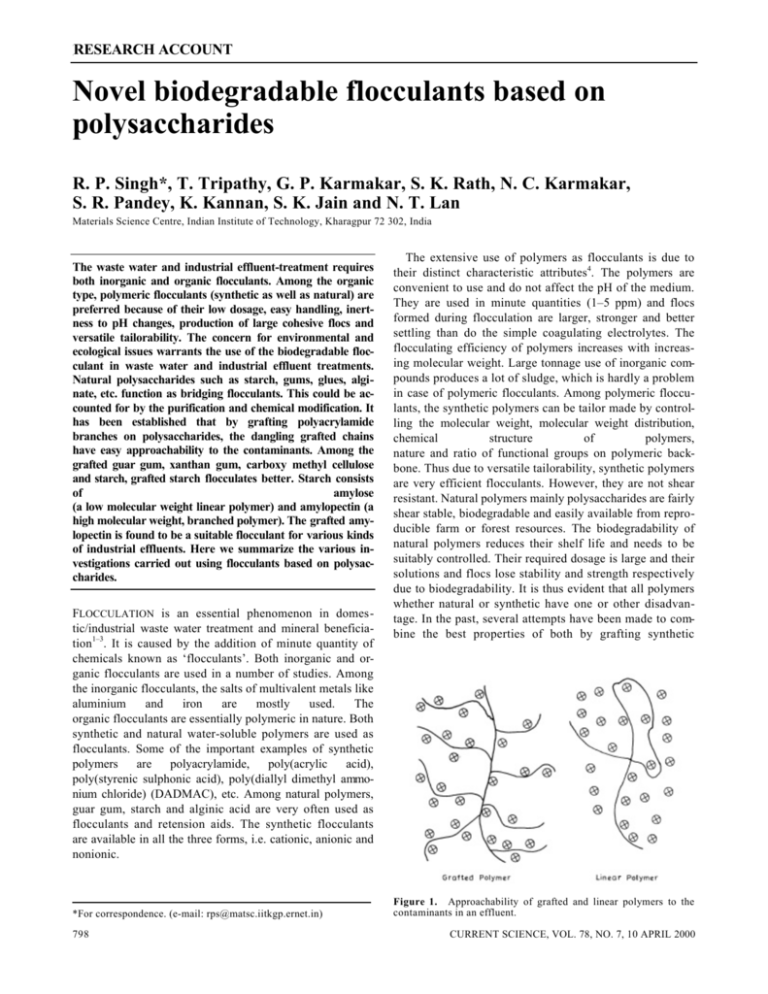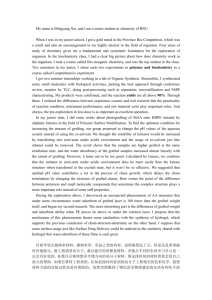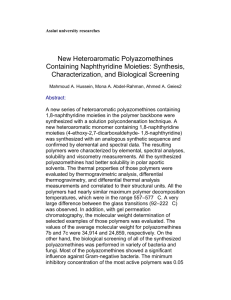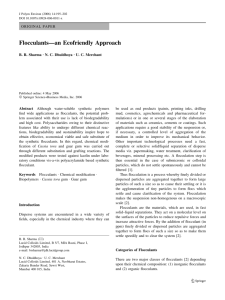Novel biodegradable flocculants based on polysaccharides
advertisement

RESEARCHACCOUNT ACCOUNT RESEARCH Novel biodegradable flocculants based on polysaccharides R. P. Singh*, T. Tripathy, G. P. Karmakar, S. K. Rath, N. C. Karmakar, S. R. Pandey, K. Kannan, S. K. Jain and N. T. Lan Materials Science Centre, Indian Institute of Technology, Kharagpur 72 302, India The waste water and industrial effluent-treatment requires both inorganic and organic flocculants. Among the organic type, polymeric flocculants (synthetic as well as natural) are preferred because of their low dosage, easy handling, inertness to pH changes, production of large cohesive flocs and versatile tailorability. The concern for environmental and ecological issues warrants the use of the biodegradable flocculant in waste water and industrial effluent treatments. Natural polysaccharides such as starch, gums, glues, alginate, etc. function as bridging flocculants. This could be accounted for by the purification and chemical modification. It has been established that by grafting polyacrylamide branches on polysaccharides, the dangling grafted chains have easy approachability to the contaminants. Among the grafted guar gum, xanthan gum, carboxy methyl cellulose and starch, grafted starch flocculates better. Starch consists of amylose (a low molecular weight linear polymer) and amylopectin (a high molecular weight, branched polymer). The grafted amylopectin is found to be a suitable flocculant for various kinds of industrial effluents. Here we summarize the various investigations carried out using flocculants based on polysaccharides. FLOCCULATION is an essential phenomenon in domestic/industrial waste water treatment and mineral beneficiation1–3. It is caused by the addition of minute quantity of chemicals known as ‘flocculants’. Both inorganic and organic flocculants are used in a number of studies. Among the inorganic flocculants, the salts of multivalent metals like aluminium and iron are mostly used. The organic flocculants are essentially polymeric in nature. Both synthetic and natural water-soluble polymers are used as flocculants. Some of the important examples of synthetic polymers are polyacrylamide, poly(acrylic acid), poly(styrenic sulphonic acid), poly(diallyl dimethyl ammonium chloride) (DADMAC), etc. Among natural polymers, guar gum, starch and alginic acid are very often used as flocculants and retension aids. The synthetic flocculants are available in all the three forms, i.e. cationic, anionic and nonionic. *For correspondence. (e-mail: rps@matsc.iitkgp.ernet.in) 798 The extensive use of polymers as flocculants is due to their distinct characteristic attributes4. The polymers are convenient to use and do not affect the pH of the medium. They are used in minute quantities (1–5 ppm) and flocs formed during flocculation are larger, stronger and better settling than do the simple coagulating electrolytes. The flocculating efficiency of polymers increases with increasing molecular weight. Large tonnage use of inorganic compounds produces a lot of sludge, which is hardly a problem in case of polymeric flocculants. Among polymeric flocculants, the synthetic polymers can be tailor made by controlling the molecular weight, molecular weight distribution, chemical structure of polymers, nature and ratio of functional groups on polymeric backbone. Thus due to versatile tailorability, synthetic polymers are very efficient flocculants. However, they are not shear resistant. Natural polymers mainly polysaccharides are fairly shear stable, biodegradable and easily available from reproducible farm or forest resources. The biodegradability of natural polymers reduces their shelf life and needs to be suitably controlled. Their required dosage is large and their solutions and flocs lose stability and strength respectively due to biodegradability. It is thus evident that all polymers whether natural or synthetic have one or other disadvantage. In the past, several attempts have been made to combine the best properties of both by grafting synthetic Figure 1. Approachability of grafted and linear polymers to the contaminants in an effluent. CURRENT SCIENCE, VOL. 78, NO. 7, 10 APRIL 2000 RESEARCH ACCOUNT polymers onto the backbone of natural polymers after purification5,6. One of the great advantages thus gained is the consequent reduced biodegradability because of the drastic change in the original regular structure of the natural polymer as well as the increased synthetic polymer content within the product. It is also observed that grafting of shear degradable polymers onto rigid polysaccharide backbone provides fairly shear stable systems6,7. It was envisaged6 that by grafting flexible polyacrylamide chains on polysaccharides such as guar gum, xanthan gum, carboxy-methyl cellulose and starch, it is possible to develop efficient, shear stable and biodegradable flocculants for treatment of industrial effluents and mineral processing. In these flocculants, the flexible chains of polyacrylamide are grafted onto rigid backbone of polysaccharides. Hence, the approachability of polyacrylamide chains for metallic and non-metallic contaminants increases significantly6 (Figure 1). Thus they are endowed with highly efficient attributes. Surface charges are generated on the solid particles in a suspension by three ways 8. One is the isomorphic substitution in the solid lattice. The second is the ionization of surface groups (such as an –OH group in mineral oxides, carboxyl groups for latex particles and carboxyl or amino groups for proteins). The third method is the preferential adsorption of ions or ionisable species from the suspending medium. Because of this surface charge, ions of opposite charge in the solution will be attracted towards the surface. There will be a higher concentration of counter ions close to the surface, than in the bulk of the liquid. This concentration falls off with increasing distance from the particle surface. Thus, there is a bound layer (Stern layer) of counter ions at the particle surface and after this layer, a more diffuse layer still exists. Only the bound layer moves with the particles. So there is a plane of shear between the bound layer and the diffuse layer. The potential difference between the plane of shear and the bulk solution is called the ‘zeta potential’. These phenomena give rise to the electrical double layer which surrounds the colloidal particles. The double layer composed of the Stern and diffusive layers is shown in Figure 2. Because Figure 4. Variation of sedimentation time with concentration of lead slurry by addition of 2 ppm of various flocculants. Figure 2. Electrical double layer (Priesing9 ). Figure 3. Configuration of an adsorbed polymer chain (G. J. Fleer et al. 1933). CURRENT SCIENCE, VOL. 78, NO. 7, 10 APRIL 2000 Figure 5. Variation of supernatant turbidity with flocculant dose in kaolin suspension (0.25%) in water: The comparison among Ap–g– PAM 4, St–g–PAM and Am–g–PAM. (Ref. 2 in J. Appl. Polym. Sci., 1997, 66, 1721). 799 RESEARCH ACCOUNT of the repulsive forces between the particles, charged this way, the suspension can be stabilized9. Flocculation occurs due to this destabilization of the colloidal particles, by the addition of some water-soluble polymers. The major mechanisms of flocculation by polyelectrolytes Table 1. Flocculation characteristics of grafted polysaccharides in synthetic effluents • The effect of molecular parameters of graft copolymers of guar gum and polyacrylamide (GM1 ) was evaluated in the synthetic effluent of lead. The maximum efficiency was shown by GM3 , followed by GAM4 and GAM5 29,30 . Among this series GM3 has fewer but longer grafted chains of polyacrylamide. It appears that the presence of lead ions in the effluent, caused the straightening effect on the polymer chains. Due to this the polymer chain has not assumed globular form, thus making available all hydrogen bond-forming sites to participate in the flocculation by bridging mechanism. GAM5 with more number of shorter grafts showed poor performance but still its flocculation efficiency was much higher than that of commercial polyacrylamide-based flocculant 6,21,29,30 . The synthesis of GM3 was scaled up and tested for various synthetic and industrial effluents29,30 . It was observed that GM3 performs better than guar gum and commercial flocculant based on polyacrylamide (Figure 6). • Among xanthan gum–g–acrylamides, (XM3 ) 16,17 is the most effective drag reducing having fewer but longer grafted polyacrylamide chains on xanthan gum backbone. Its synthesis was scaled up31 . Its efficiency was tested in synthetic effluent containing lead and paper mill effluent. In lead effluent, its performance is better than commercial and purified xanthan gum and polyacrylamide. However the performance of GM3 is better than XM3 and reason for this observation has been discussed elsewhere6,17,21,31 . In paper mill effluent treatment, the polymer acts as flocculant and aids along with alum17,31 . • Starch is used extensively for mineral treatment2,3,32-38 . Hence it was contemplated that grafted starch may have better performance as flocculant. As starch–g–acrylamide (SAM) has fewer and longer branches, it was chosen for scale up and testing for synthetic as well as industrial effluents. A comparative study6 was conducted for synthetic lead slurry. It has been found that this provides the best flocculating performance. At alkaline pH and higher shear rates, this flocculant performs better than the flocculants available commercially38 . • Starch consists of a linear polymer amylose of low molecular weight (in range of 10,000–60,000) and branched amylopectin, which is major fraction of high molecular weight (in range of 50,000–10 6 ). The performance of grafted amylose is inferior to grafted starch22,23,38 . • A large number of graft copolymers of amylopectin and polyacrylamide were synthesized (Ap–g–PAM1, Ap–g–PAM8) and their flocculation efficiency has been evaluated in kaolin suspension, coal suspensions and paper mill effluent22,36,24 . It was found that Ap–g–PAM is the best flocculant (Figure 5) compared to St– g–PAM and Am–g–PAM. Enhanced efficiency of Ap–g–PAM is because of its greater degree of branching and higher molecular weight. Among the various graft copolymers, the one which has fewer but longer branch gives the best performance. • A number of graft copolymers of sodium alginate and polyacrylamide (SAGI–SAGV) have been synthesized. Their performance is inferior to AP–g–PAM but their performance is better than many commercial flocculants. Similar is the performance of grafted CMC37,39 . • When the grafted branches are partially hydrolysed in SAG–g– PAM, the performance increases to a certain level and then decreases. During hydrolysis, the grafted chains are straightened, due to electrostatic repulsion of negatively charged carboxylate anions. As a result, the approachability to the particles in a colloidal suspensions increases. There is an optimum degree of hydrolysis where grafted chains get straightened but have some degree of flexibility. Beyond the optimum level, the grafted chains lose their flexibility and behave like a rigid rod. As a result, floccula800 are surface charge neutralization and bridging. Surface charge neutralization occurs if the charge of the flocculants is opposite in sign to that of the suspended particles. Addition of such a polymer to the suspension will result in aggregation caused by specific ion absorption. For neutral flocculants, the major mechanism of flocculation is the polymer bridging. The controversy concerning the bridging and charge neutralization mechanisms of aggregating aqueous suspensions by the adsorption of water soluble polymers is long standing. In their early experimental and theoretical investigations, Lamer and his school10 were prominent in advocating bridging. Hence there is no question that the bridging mechanism operates with uncharged polymers to the particles of the suspension. When very long polymer molecules are absorbed on the surface of particles, they tend to form loops that extend some distance from the surface into the aqueous phase, and their ends may dangle. These loops and ends may come into contact with, and attach to, another particle forming a bridge between the two particles. This is the bridging mode of flocculation11. Here charge of the particles/and or polymer do not play any important role. The reason for better flocculating power of the graft copolymers over the linear polymers is as follows; essentially polymer bridging occurs because segments of a polymer chain absorb on different particles, thus linking the particles together. In order for effective bridging to occur there must be sufficient chain lengths, which extend far enough from the particle surface to attach to other particles. Table 2. Flocculation characteristics of grafted polysaccharides in industrial effluents • For the industrial effluents containing nickel, copper and lead ions, the performance of grafted guar gum is better than that of guar gum and Tulespar (a commercial flocculant)29,30 . • For industrial effluents from a copper industry (HCL, Ghatsila, India), the grafted starch (SAM–g–II) is better than Magnafloc1011 at lower concentrations of the flocculant38 . • In flocculation of hematite slimes, the grafted starch is found to be an efficient flocculant with small dose compared to Magnafloc1011 in the normal and acidic pH range. At alkaline pH, grafted starch works even better than Magnafloc-101 (ref. 38). • For flocculation of iron ore and Kiriburu slime pond overflows, greater settling rate of particles was observed using Magnafloc1011 when flocculant dose was 30 ppm and pulp density 10% than that using Ap–g–PAM, SAM-II and SAG-II. However, at 10 ppm flocculant dose, the performance of Ap–g–PAM and SAM-II was better than other commercial effluents35 . • Settling and filtration experiments were also performed with commercial and laboratory synthesized biodegradable flocculants on iron ore slimes. It is observed at flocculant dose of 10 ppm the settling performance of Ap–g–PAM and SAM-II was better than Magnafloc-1011 (Figure 7). In the filtration experiments, the performance of SAM-II is much better than SAG-II and Magnafloc-1011 at normal pH35 (Figure 8). • The flocculation and settling characteristics of coking and noncoking coal suspensions were studied using biodegradable flocculants. The non-coking coals do not settle quickly and supernatant turbidity is quite high. Considering settling velocity and residual supernatant turbidity of the coal suspensions, the performance of Ap–g–PAM is better followed by St–g–PAM both for coking and non-coking coals36 (Figure 9). CURRENT SCIENCE, VOL. 78, NO. 7, 10 APRIL 2000 RESEARCH ACCOUNT In case of linear polymers, the polymer segments attached to the surface in trains, project into the solution as tails, or form part of loops, which links trains together12. By this way they can form bridges between the colloidal particles to form flocs. This is shown in Figure 3. But for the graft copolymers, the dangling grafted chains can easily bind the colloidal particles through bridging to form flocs. This type of intense bridging is not possible in case of linear polymers. Many graft copolymers have been synthesized by grafting polyacrylamide chains onto guar gum13–15, xanthan gum16,17 carboxy methyl cellulose and starch18. Their shear stability and drag reduction efficiency have been exten- Figure 6. Figure 7. sively studied6,14. It has been found that by varying the number and length of the grafted polyacrylamide chain onto the backbone, the graft copolymers having fewer and longer chains are more efficient as drag reducing agent13-19. Later on, the investigations on their flocculation ability yield the same pattern, i.e. the graft copolymers having fewer and longer grafted chains are found to be more effective flocculants6. Among the grafted guar gum, xanthan gum, carboxy methyl cellulose, sodium alginate and starch, it has been found that grafted starch is the most efficient flocculant6,20–25 (Figure 4). Starch consists of linear amylose (molecular weight 10,000–60,000) and branched amylopectin (Mw = 50,000–106). Hence amy- Effect of graft copolymers on flocculation of lead synthetic slurry. Variation of height of interface with time. CURRENT SCIENCE, VOL. 78, NO. 7, 10 APRIL 2000 Figure 8. Variation of total volume of filtrate with time. 801 RESEARCH ACCOUNT Figure 9. The settling velocity and turbidity versus polymer dosage. lose and amylopectin was grafted with polyacrylamide chains. Among all the polysaccharides, grafted amylopectin22–24 has been found to have best flocculation efficiency (Figure 5), giving credence to the proposed model6. Most polysaccharides are purified before use7. The various graftcopolymers have been synthesized by ceric ion initiated solution polymerization technique13–25. In this technique, the free radicals are formed exclusively on the polysaccharide molecules, thus minimizing the formation of homopolymers. Further, the acrylamide and ceric ammonium nitrate concentration was kept below 2.0 M within the limits of Owen and Shen26 to ensure proper grafting. Graft copolymers are characterized27 by viscometry, IR, NMR, thermal analysis, morphological study and XRD. Recently the proof of grafting has been given by enzyme hydrolysis28. Biodegradation can be followed by monitoring absolute viscosity at certain interval of times over entire period of the test at 30°C when bacterial activity is maximum. As mentioned earlier grafted polysaccharides are less prone to biological attack30. The standard jar test and settling tests were followed for measurement of flocculation and settling characteristics22–24. First the effectiveness as flocculant was measured in synthetic effluents of kaolin, PbNO3 and coal. Later on industrial effluents from steel, copper, electroplating industries, iron ore mines and coal washeries were treated. In most cases, comparative studies were done with commercial effluents. The summary of above investigations is given in Tables 1 and 2. On the basis of above discussion, it can be concluded that grafted polysaccharides are shear stable, efficient floc802 culating and settling aids for industrial effluent treatment and mineral processing. Of all the grafted polysaccharides, polyacrylamide grafted amylopectin having fewer but longer branches gives the best performance in a variety of synthetic and industrial effluents. As amylopectin itself is branched, its grafted chains will have more approachability to contaminants in the effluent6. 1. Bolto, B. A., Progr. Polym. Sci., 1995, 20, 987–1041. 2. Moody, G., Mineral Engg., 1992, 5, 479–492. 3. Bratby, J., Coagulation and Flocculation, Uplands Press Ltd, Cryodon, Cambridge, 1980, 1st edn. 4. Levine, S. and Friesen, W. I., in Flocculation in Biotechnology and Separation Systems (ed. Attia, Y. A.), Elsevier, Amsterdam, 1987, pp. 3–15. 5. Swanson, C. L., Shogren, R. L., Fanta G. F. and Imam, S. H., J. Environ. Polym. Degradation, 1993, 1, 155–166. . 6. Singh, R. P., Advanced Turbulent Drag Reducing and Flocculating Materials Based on Polysaccharides in Polymers and Other Advanced Materials: Emerging Technologies and Business Opportunities (eds Prasad, P. N., Mark, E. and Fai, T. J.), Plenum Press, New York, 1995, pp. 227–49. 7. Singh, R. P., Karmakar, G. P., Rath, S. K., Karmakar, N. C., Pandey, S. R., Tripathy, T., Kannan, K., Jain, S. K. and Lan, N. T., Based on Invited Talk, Polymer Eng. Sci., 1999 (in press). 8. Stumm, W., Morgan, J. J., JAWWA, 1962, 54, 971–991. 9. Priesing, C. P., Indian Eng. Chem., 1962, 54, 38–45. 10. Lamer, V. K. and Healy, T. W., Rev. Pure. App. Chem., 1963, 13, 112–133. 11. Ruehrwein, R. A. and Ward, A., Soil Sci., 1952, 73, 485. 12. Dickinson, E. and Eriksson, L., Adv. Colloid Interface Sci., 1991, 34, 1. 13. Deshmukh, S. R., Chaturvedi, P. N. and Singh, R. P., J. Appl. Polym. Sci., 1985, 30, 4013–4020. CURRENT SCIENCE, VOL. 78, NO. 7, 10 APRIL 2000 RESEARCH ACCOUNT 14. Deshmukh, S. R. and Singh, R. P., J. Appl. Polym. Sci., 1985, 30, 4013–4020. 15. Deshmukh, S. R. and Singh, R. P., J. Appl. Polym. Sci., 1987, 33, 1963–1975. 16. Deshmukh, S. R. and Singh, R. P., J. Appl. Polym. Sci., 1986, 32, 6133–6177. 17. Ungeheur, S. R., Bewersdorff, H. W. and Singh, R. P., J. Appl. Polym. Sci., 1989, 37, 2933–2948. 18. Deshmukh, S. R., Sudhakar, K. and Singh, R. P., J. Appl. Polym. Sci., 1991, 48, 1091–1101. 19. Singh, R. P., in Encyclopedia of Fluid Mechanics: Polymer Flow Engineering (ed. Cheremisinoff, I. P.), Gulf Publishing, Houston, 1990, vol. 9, pp. 425–480. . 20. Singh, R. P., Popular Plastic Packaging, 1994, 39, 69. 21. Singh, R. P., Jain, S. K. and Lan, N., Drag Reduction, Flocculation and Rheological Characteristics of Grafted Polysaccharides in Polymer Science Contemporary Themes (ed. Sivaram, S.), Tata McGraw Hill, New Delhi, 1991, pp. 716–721. 22. Rath, S. K. and Singh, R. P., J. Appl. Polym. Sci., 1997, 66, 1721–1729. 23. Karmakar, G. P. and Singh, R. P., Colloids and Surfaces A: Physiochemical and Engineering Aspects, 1998, 113, 119– 124. 24. Rath, S. K. and Singh, R. P., Colloids and Surfaces A: Physiochemical and Engineering Aspects, 1998, 139, 129–135. 25. Karmakar, N. C., Rath, S. K., Sastry, B. S. and Singh, R. P., J. Appl. Polym. Sci., 1998, 70, 2619–2625. 26. Owen, D. R. and Shen, T. C., in Structure Solubility Relationship in Polymers (eds Harris, F. W. and Seymour, R. P.), Academic Press, New York, 1977. 27. Rath, S. K. and Singh, R. P, J. Appl. Polym. Sci., 1998, 70, 1795–1810. 28. Rath, S. K. and Singh, R. P., J. Appl. Polym. Sci., 1998, 70, 2627–2633. 29. Kannan, K., M.Tech. thesis, IIT, Kharagpur, 1988. 30. Jain, S. K., M.Tech. thesis, IIT, Kharagpur, 1989. 31. Lan, N. T., M.Tech. thesis, IIT, Kharagpur, 1990. CURRENT SCIENCE, VOL. 78, NO. 7, 10 APRIL 2000 32. Karmakar, G. P. and Singh, R. P., Synthesis and Characterisation of Starch–g–Acrylamide Copolymers for Improved Oil Recovery, SPE 37297, Houston, USA, 1996. 33. Karmakar, G. P. and Singh, R. P., Synthesis and Application of Polymeric Flocculants for the Treatment of Paper Mill Effluents, Advances in Chemical Engineering, Allied Publishers, New Delhi, 1996, p. 201. 34. Bhagat, R. P., Karmakar, G. P. and Singh, R. P., Filtration of Iron Ore Slimes Using Synthesised Copolymer, Recent Advances in Metallurgical Processes, New Age International, New Delhi, 1997, pp. 89–93. . 35. Pandey, S. R., Tripathy, T., Bhagat, R. P. and Singh, R. P., Behaviour of Iron Ore Slimes Using Various Polymeric Flocculants in Macromolecules, New Frontiers (ed. Srinivasan, K. S. V.), Allied Publishers, New Delhi, 1998, pp. 1118–1121. . 36. Karmakar, N. C., Sastry, B. S. and Singh, R. P., Settling Characteristics of Coking and Non–Coking Coal Fines, (ed. Srinivasan, K. S. V.), Allied Publishers, New Delhi, 1998, vol. 2, pp. 1114– 1117. 37. Tripathy, T., Pandey, S. R., Bhagat, R. P. and Singh, R. P., (ed. Srinivasan, K. S. V.), Allied Publishers, New Delhi, 1998, vol. 2, 1084–1087. 38. Karmakar, G. P., Ph D thesis, IIT, Kharagpur, 1994. 39. Tripathy, T., Pandey, S. R., Karmakar, N. C., Bhagat, R. P. and Singh, R. P., Eur. Polym. J., 1999, 35, 2057–2072. . 40. Tripathy Tridib and Singh R. P., Eur. Polym. J., 2000 (in press). ACKNOWLEDGEMENTS. We acknowledge the support offered by Prof. F. Durst, Lehrstuhl Fur Stromungmechanik, F.A. University of Erlangen–Nuremberg, Germany and DAAD. Financial support from CSIR, New Delhi and IIT Kharagpur is also gratefully acknowledged. Received 16 March 1999; revised accepted 29 January 2000 803







